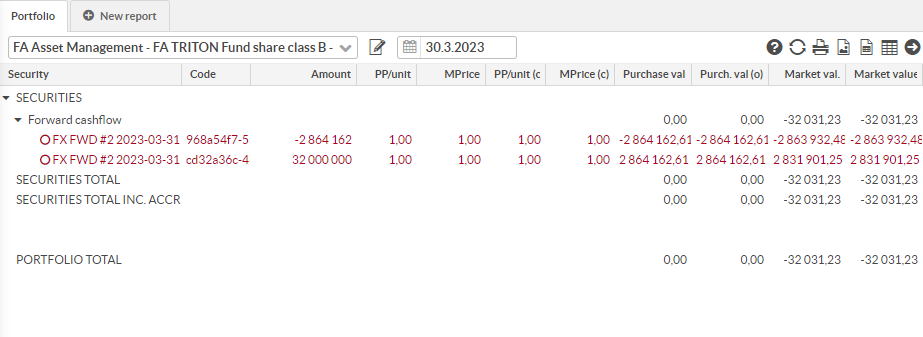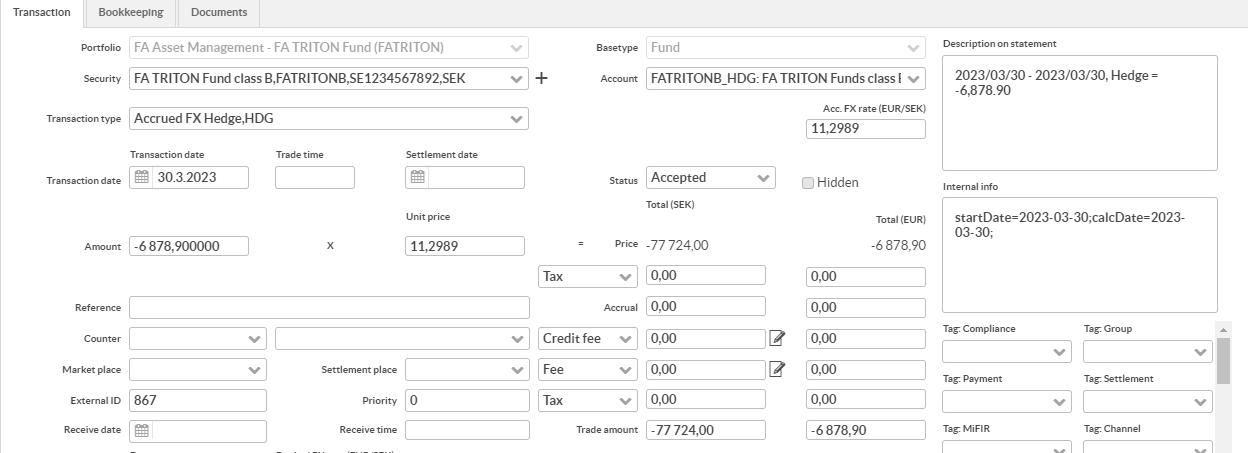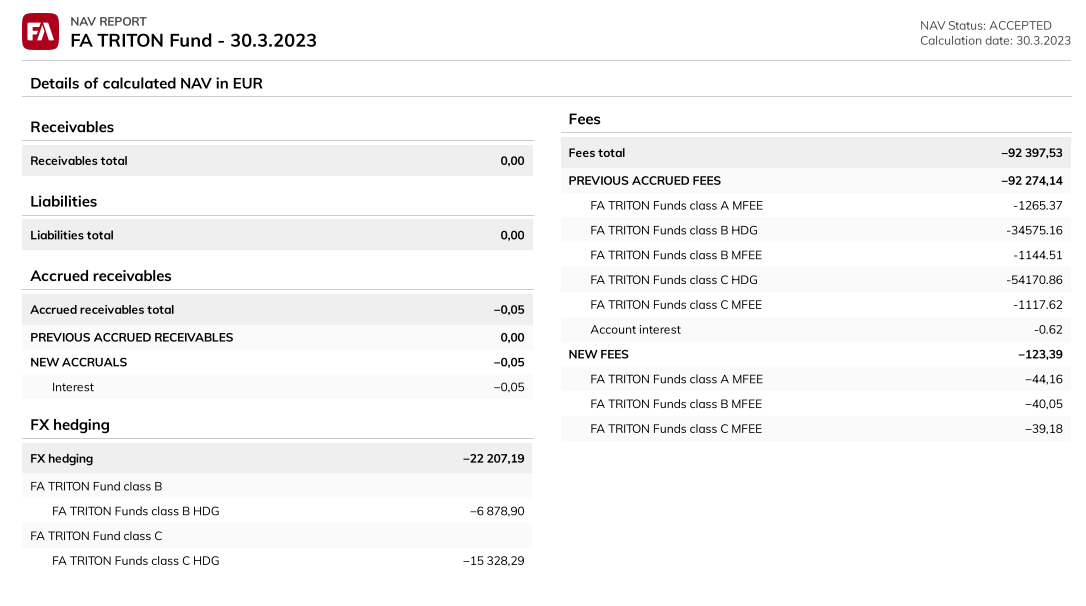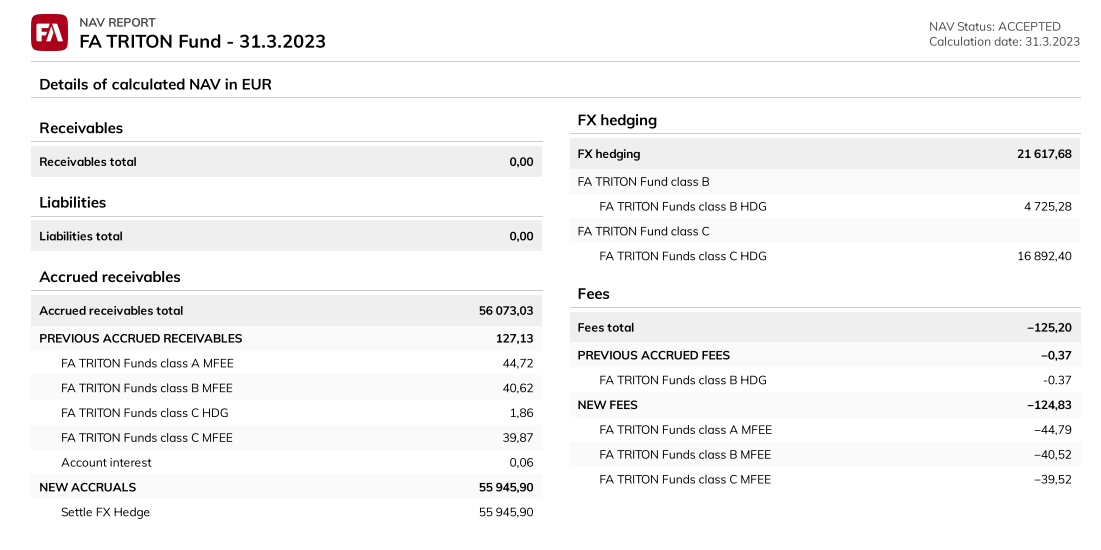Hedge currency exposure
FX hedging is used by the funds that have share classes denominated in other currency than the fund itself. It allows the fund to protect the investor returns from fluctuations in the exchange rate between the fund base currency and the share class currency. For this, the fund uses FX Forward contracts that balance the share class currency exposure.
To manage your fund with FX-hedged share classes, follow the workflow:
Set up the fund, share classes and FX hedging. You need to set up the fund and share classes in FA Fund management app, and create FX Forward contracts. If you already created fund and share classes, make sure that the settings listed in the instructions below are in place.
Calculate NAV with hedge accrual. When you calculate NAV, the system calculates the change in the FX Forward market value and creates a share class-related “Accrued FX Hedge” (HDG) transaction to accrue the amount to the fund portfolio account. FA Fund management app shows accrued FX Hedging in the NAV calculation.
Settle FX contracts. When the FX Forward is settled, the system calculates profit and loss from FX Forward contracts and creates a cash-in transaction to the fund bank account.
Set up the fund and FX hedging
A fund with hedged share classes is represented by a two-level portfolio structure that you can view in FA Back. The portfolio structure includes the fund portfolio and FX hedge portfolios per share class on the lower level and a parent portfolio that links them together on the higher level. The FX hedge portfolios contain FX Forward and FX Swap contracts. The parent portfolio is empty. It is used to group the fund and FX hedge portfolios and share accounts between them.
Here's an example of such a structure for an ABC fund that has two FX-hedged share classes:
Hedge parent portfolio: "ABC Fund parent" (empty)
Fund portfolio: "ABC Fund" (with the fund portfolio holdings)
FX hedge portfolio: "ABC Fund share class A FX hedged" (with share class A FX contracts)
FX hedge portfolio: "ABC Fund share class B FX hedged" (with share class B FX contracts)
To accrue FX hedge on the fund account and settle FX forward contracts, FA Fund management uses fee functionality. This means you need to set up FX hedge accrual and FX forward settlement as fee formulas linked to the share class and the fund. For details, see the instructions below.
Create a fund with FX hedging
To set up the fund with FX-hedged share classes, you need to add accounts in different currencies and a fee formula for the FX hedge settlement:
In the NAV status view, click Add fund to create a fund (see Create a fund). If the fund already exists, click on it in the list and open the fund settings by clicking
 in the side pane.
in the side pane.Add the following accounts in the Basic info tab:
Share class accounts in the share class currency. Select Share to all parent portfolio’s subportfolios option.
Define the FX hedge settlement settings in the Fee structure tab. Click Add fee and fill in the fields:
Fee formula and Fee transaction type. A fee formula and linked transaction type to settle FX hedging. Choose "FX hedge settlement offset" formula with the "Settle FX Hedge (HDGS)" transaction type. This formula must be the first in the list of formulas in the Fee structure tab.
Formula sets the transaction account: Tick the checkbox.
You can leave the rest of the fields for the added fee empty.
After you set up the fund, proceed to define the share class settings.
Create FX-hedged share classes
To add FX-hedged share classes:
Click on a fund in the list and click
 to add share classes (see Add share classes).
to add share classes (see Add share classes).Choose Enable FX hedging in the FX Hedging tab and enter the following information:
Formula and FX hedge transaction type. A fee formula and linked transaction type to use for the FX hedge accrual. Choose "FX hedge formula" with the "Accrued FX hedge (HDG)" transaction type.
Hedge parent portfolio. Hedge parent portfolio that is used to group the fund and hedge portfolios and share accounts between them. Edit the portfolio ID if needed.
Hedge portfolio. The portfolio to store the FX contracts. Edit the portfolio ID if needed.
As a result, FA creates portfolios per share class in FA Back. The accrued hedge accounts per share class are added in the fund portfolio.
Set up FX hedging for share classes
To set up FX hedging for the fund share classes:
Open the fund portfolio in FA Back. Find the hedge parent portfolio and hedge portfolios per share class automatically created when you set up the fund and share classes.
Enter the FX contracts for hedging of each share class in the FX hedge portfolio for the share class. For details about FX contracts, see FX contracts in FA User guide. In the contracts, add the shared accounts in the share class currency that you created (see FX Forward).
Calculate NAV with hedge accrual
Calculate the fund NAV on the NAV calculation date in FA Fund management app. The NAV calculation takes into account the market value change of the FX Forward contracts. In the example below, the market value of the hedge portfolio for share class B rose from 25 152,33 on March 29 to 32 032,23 on March 30.


When you accept NAV, FA Fund management creates an Accrued FX Hedge (HDG) transaction to accrue the difference in the market value on the fund account. The details are recorded in the Description on statement and Internal info fields.

The accrued FX hedge affects the value of the related share class:

Settle FX Forward contracts
On the day when FX Forward contracts are settled, the total realized profit and loss on FX Forward flows is added to the contract market value and accrued to the fund using the FX Hedge settlement offset (HDGS) transaction.
You can see it under the Accrued receivables section in the NAV window:
